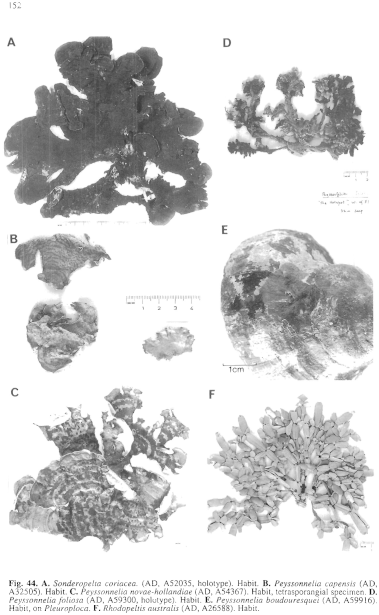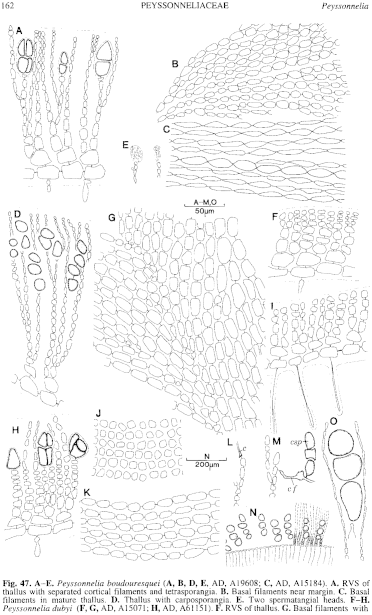|
|
|
|
|
|||||||||||
|
Electronic Flora of South Australia Species Fact Sheet
Phylum Rhodophyta – Class Florideophyceae – Order Gigartinales – Family Peyssonneliaceae
Synonym
P. atlantica Schneider & Reading 1987: 176, figs 1–15.
Thallus (Fig. 44E) medium to dark red or red-brown, 1–3 (–5) cm across, orbicular or broadly lobed, completely adherent to the substrate (molluscs or rock), 120–320 µm thick, without growth zones but with a wrinkled surface (largely due to the substrate). Structure. Basal layer (Fig. 47B, C) of radiating lines of cells in broad flabellules, each often with a central filament of slightly broader cells 10–14 µm in diameter and L/D 2–3, with the other cells from below 8–12 µm broad and L/D 2–4, from the side (in RVS) 15–30 µm high and L/D 1–2 (–3), producing below occasional, short, unicellular rhizoids, usually with a short basal cell within the thallus sheath; hypobasal calcification slight. Erect filaments (Fig. 47A) assurgent at 60–80°, attached centrally or slightly anteriorly to the basal layer cells, the lowest cell conical with a truncated top, (15–) 20–30 µm in diameter and L/D 1–2, furcate occasionally for the lower 1–4 cells and tapering to 6–12 µm in diameter, then to a long slender filament (simple or occasionally furcate) easily separable in its gelatinous matrix but with the filament apices held in the surface pellicle; filaments 100–200 µm and 11–18 cells long, mid cells 3–7 µm in diameter and L/D 2–5, upper 3–4 cells 5–8 µm in diameter and L/D (0.5–) 1–1.5.
Reproduction: Sexual plants monoecious. Carpogonial branches in shallow nemathecia, terminating short branches, carposporangia (Fig. 47D) in short chains or clusters, within nemathecia, each isodiametric to ovoid, 15–20 µm in diameter. Spermatangia (Fig. 47E) borne in ovoid heads.
Tetrasporangia (Fig. 47A) borne terminally on 2–5-celled lateral branches of the erect slender filaments, lying within this region, 30–60 µm long and 24–30 µm in diameter, cruciately (more or less decussately) divided.
Type from Ponta Leste, Arraialdo Cabo, Brazil; holotype YY4053F in Herb. Instit. Pesquisas da Marinha, RJ, Brazil.
Selected specimens: Head of the Great Australian Bight, S. Aust., epilithic in shaded pool (Womersley, 4.ii.1954; AD, A19321). Scotts Bay, S.Aust., reef pools on Turbo (Womersley, 27.i.1951; AD, A15070). Point Sinclair, S. Aust., upper sublittoral on Turbo (Womersley, 9.ii.1954; AD, A19608). Elliston, S. Aust., in upper sublittoral pool, inner reef, on the mollusc Pleuroploca australasia (Womersley, 15.i.1951; AD, A59916). Topgallant I., S. Aust., 10 m deep on Haliotis laevigata (O'Leary, 22.i.1992; AD, A61653). Louth Bay, S. Aust., upper sublittoral on Thais (Womersley, 5.i.1951; AD, A15184).
Distribution: Brazil; North Carolina, U.S.A.
In southern Australia, from the Head of the Great Australian Bight to Louth Bay, S.Aust.; probably more widely distributed. It occurs mainly on shells of molluscs but is also epilithic.
Taxonomic notes: The above specimens agree well with descriptions of P. boudouresquei Yoneshigue from Brazil, and have been checked by Dr Christine Maggs, who pointed out that P. atlantica Schneider & Reading is a synonym.
References:
SCHNEIDER, C.W. & READING, R.P. (1987). A revision of the genus Peyssonnelia (Rhodophyta, Cryptonemiales) from North Carolina, including P. atlantica new species. Bull. Mar. Sci. 40, 175–192.
YONESHIGUE, Y. (1984). Flore marine de la region de Cabo Frio (Brésil). 4. Sur une espèce nouvelle du genre Peyssonnelia (Cryptonemiales: Rhodophyta). Vie Milieu 34, 133–137.
The Marine Benthic Flora of Southern Australia Part IIIA complete list of references.
Publication:
Womersley, H.B.S. (14 January, 1994)
The Marine Benthic Flora of Southern Australia
Rhodophyta. Part IIIA, Bangiophyceae and Florideophyceae (to Gigartinales)
Reproduced with permission from The Marine Benthic Flora of Southern Australia Part IIIA 1994, by H.B.S. Womersley. Australian Biological Resources Study, Canberra. Copyright Commonwealth of Australia.
Illustrations in Womersley Part IIIA, 1994: FIGS 44E, 47 A–E.

Figure 44 enlarge
Fig. 44. A. Sonderopelta coriacea. (AD, A52035, holotype). Habit. B. Peyssonnelia capensis (AD, A32505). Habit. C. Peyssonnelia novae-hollandiae (AD, A54367). Habit, tetrasporangial specimen. D. Peyssonnelia foliosa (AD, A59300, holotype). Habit. E. Peyssonnelia boudouresquei (AD, A59916). Habit, on Pleuroploca. F. Rhodopeltis australis (AD, A26588). Habit.

Figure 47 enlarge
Fig. 47. A–E. Peyssonnelia boudouresquei (A, B, D, E, AD, A19608; C, AD, A15184). A. RVS of thallus with separated cortical filaments and tetrasporangia. B. Basal filaments near margin. C. Basal filaments in mature thallus. D. Thallus with carposporangia. E. Two spermatangial heads. F–H. Peyssonnelia dubyi (F, G, AD, A15071; H, AD, A61151). F. RVS of thallus. G. Basal filaments with flabellules. H. RVS of thallus with tetrasporangia. I-0. Peyssonnelia inamoena (AD, A59853). 1. RVS of thallus. J. Surface (upper) pattern of erect filaments. K. Basal filaments. L. Carpogonial branch. M. Young carposporangia from connecting filament. N. Carposporangia in a female nemathecium. 0. Mature carposporangia.

|
Email Contact: State Herbarium of South Australia |

|